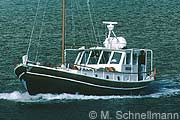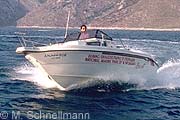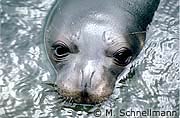The Monachus Guardian moves home
The editorial team welcomes readers to the new home of The Monachus Guardian, the world’s only Internet journal dedicated to monk seals, their shrinking habitat, and the forces threatening their survival.
If you have been a regular visitor to our publication in the past, we suggest you bookmark the new site (www.monachus-guardian.org) now for added convenience.
In addition to current and back issues of The Monachus Guardian, readers will also find other familiar and well-trusted resources on site, including the recently-updated Monachus Library, and Monachus Profiles. Time permitting, we also hope to develop another recently-registered Internet domain, www.monachus.info, publishing a comprehensive catalogue of monk seal information resources available online, indexed by subject.
We also take this opportunity of extending our warmest thanks to the hundreds of readers who have written in to express their support for the continued publication of The Monachus Guardian [see Letters to the Editor].
Although the survival of the journal has been placed in serious jeopardy by the abrupt departure of its former sponsor and publisher [Breaking News archive], we decided to proceed with the May issue as originally planned, encouraged by growing institutional support from other quarters and deepening ties with frontline monk seal conservation organizations. Such support makes it all the more likely that we will be able to publish the November 2002 issue as originally planned, and also secure longer-term financial backing.
PS: If you have not already signed our online Petition, but find The Monachus Guardian a valuable source of information on the study and conservation of monk seals and their threatened habitats, please take the time to add your ‘signature’ to the list. Your voice can be persuasive! – the team @ TMG.
Prince issues appeal
|
 |
|
|
Although no longer involved in monk seal conservation on an operational level, the Bellerive Foundation and long-time friend of the monk seal, Prince Sadruddin Aga Khan [Guest Editorial, TMG 2(2): November 1999], reacted swiftly to news of TMG’s possible closure, pledging emergency aid that the Geneva-based organisation hopes will act as a “catalyst” to encourage wider institutional funding support for the journal.
In issuing an appeal to a number of other international conservation organisations, the Prince expresses his hope that the NGOs will match his commitment and also seek ways in which TMG can be put on a more stable, long-term footing.
“Given its proven track record,” writes the Prince, “and a growing support base that is so vital to the conservation of any endangered species – let alone one as neglected as the Mediterranean monk seal – we believe that TMG warrants continued backing.”
Readers wishing to support the Prince’s appeal on behalf of The Monachus Guardian, either by taking out a voluntary subscription to the journal, or making a straightforward donation, will find further details on our new Seal Appeal page. Alternatively, please contact the editor by email or the offices of the Bellerive Foundation.
Annotated bibliography online
Several years in the making, the first public edition of the Annotated Bibliography on Mediterranean monk seals has now been published in electronic (PDF) format by The Monachus Guardian, and is available for download from the Monachus Library. [Karamanlidis, A.A. and W.M. Johnson, eds. 2002. Annotated Bibliography on Mediterranean monk seals (Monachus monachus). Version 1.0. The Monachus Guardian: 1-105.]
Although a work in progress (new editions are likely to be issued as new citations are added and others confirmed for accuracy), the bibliography currently consists of some 1300 references relating to the world’s most endangered pinniped, Monachus monachus.
As indicated in its accompanying introduction, the Bibliography was inspired in part by the difficulties that researchers and conservationists face in keeping track of numerous articles relating to Monachus monachus that are published every year – often in obscure journals with a limited, local distribution, and in a variety of different languages. Although access to information often takes a back seat to other research priorities, the compilers believe that it is precisely this accumulated knowledge that is indispensable to the design and application of appropriate conservation measures for the Mediterranean monk seal.
Public and private libraries in Greece, Turkey, Germany, Switzerland, the U.K. and Canada were contacted, both to gather new relevant citations and to check the accuracy of existing references. Citations that have been confirmed against the original publication appear in black typeface, while those that have yet to be verified in this manner appear in grey.
The Bibliography focuses on Mediterranean monk seal related material written after the first modern scientific description of Monachus monachus by the German naturalist Johann Hermann in 1779. For an extensive overview of material written prior to Hermann’s work, researchers are advised to consult Johnson & Lavigne (1999).
The Annotated Bibliography on Mediterranean monk seals is being made available as a cross-platform Adobe Acrobat PDF file. The electronic format offers distinct advantages over the paper-based alternative, not least of all the ability to fast-search the document according to author, year of publication, and published journal.
In order to facilitate searches according to specific topics, keywords were assigned to every reference. The keyword list employed is based on the model compiled and used by the Seal Conservation Society in its own Seal Bibliography. This list was extended in order to facilitate reference searches according to geographical area.
In order to improve future editions of the Bibliography, we ask readers to report any citation errors or omissions they may find. New references are, of course, also welcome. Please contact us at one or both of the following email addresses:
Rehab workshop convenes in Liege
A workshop on seal rehabilitation convened in Liege, Belgium, on 7 April, an adjunct to the 16th Annual Conference of the European Cetacean Society. Organised by Jeny Adroukaki of the Hellenic Society for the Study & Protection of the Monk Seal (MOm) and Yvan Larondelle of the Université Catholique de Louvain, Belgium, the Workshop – entitled Rehabilitation in theory and practice: protocols, techniques, cases – attracted some 40 participants from 12 countries.
A pinniped rehabilitation workshop was considered long overdue, in part because of the wide-ranging experience that has been brought to this relatively new science over the past decade. Originally the preserve of ardent amateurs and volunteers, pinniped rehabilitation has become increasingly sophisticated in recent years, as professional veterinarians and biologists strive to develop and perfect techniques governing rescue, treatment, rehabilitation and release into the wild. Particularly where species are severely endangered, such as the Mediterranean monk seal, rescue and rehabilitation is generally considered an important component of conservation strategy.
A keynote speech, delivered by Prof. A.D.M.E. Osterhaus, Department of Virology, Erasmus University, Rotterdam, focused on seal rehabilitation history in Europe and the need for specific techniques and protocols. Oral presentations of relevance to monk seals included:
- Androukaki, E, E. Fatsea, L. ‘t Hart, T. Kuiken, A.D.M.E. Osterhaus, E. Tounta and N. Komnenou. 2002. Treating stranded Mediterranean monk seal pups in Greece.
- Jensen, T.H., L. 't Hart, A.M. Jiddou, K. O'M Fall and A.D.M.E. Osterhaus. 2002. Successful rehabilitation of a monk seal in Mauritania.
- Mozetich, I., M. A. Cedenilla, P. Fernández de Larrinoa, L. M. González, J. Layna, F. Aparicio, L. F. López Jurado and P. López. 2002. Juvenile and subadult survival of wild and rehabilitated Mediterranean monk seal (Monachus monachus) at Cabo Blanco (western-Sahara, Mauritania).
- Robinson, I, A.J. Charles, D.M. Smith, I. Mozetich, M. A. Cedenilla, P. Fernández de Larrinoa, L. M. González, J. Layna, F. Aparicio, L. F. López Jurado and P. López. 2002. Inclusion of an acclimatization phase in the rehabilitation of a Mediterranean monk seal from the western Sahara.
In the round table discussion that followed, chaired by Dr. Ian Robinson of the RSPCA’s Norfolk Wildlife Hospital, participants exchanged views on the reintroduction of rehabilitated animals into the wild, including criteria, risks, advantages and post-release monitoring.
A workshop report, with abstracts, is expected to be published in due course. – Jeny Androukaki, MOm.
Acoustic deterrents and monk seals
The proceedings of the Workshop on Interactions between Dolphins and Fisheries in the Mediterranean, held in Rome last year, has been published by the convenors, the Istituto Centrale per la Ricerca Applicata al Mare (ICRAM). Given the fierce competition over dwindling fisheries resources in the Mediterranean, the workshop expressed concern that monk seals may be at risk from increasing deployment of acoustic deterrent devices. The report states in part:
“In considering the potentially adverse effects on other components of the Mediterranean ecosystem, monk seals are of particular concern. Turkey and the Greek islands are the two main areas where monk seals are still found. Acoustic deterrents could affect monk seals in at least two ways. The noise could keep them away from preferred haul-out areas, or attract them to nets (the ‘dinner bell’ effect) and thus contribute to entanglement or exacerbate conflict with fishermen. Most monk seal mortality in the Mediterranean is thought to be the result of retaliation by fishermen against seals because of perceived competition or damage to catch and gear. Ketten pointed out that there is no audiogram for the Mediterranean monk seal and that the existing audiogram for the related Hawaiian monk seal (Monachus schauinslandi) is based on a single animal whose hearing curve has some characteristics that suggest its responses may have been affected by disease or age.
The workshop underlined the importance of obtaining better information on monk seal hearing so that the potential effects of acoustic pollution on this highly endangered marine mammal could be properly assessed. Also, noting that the breeding and haul-out areas of Mediterranean monk seals are extremely circumscribed, the workshop strongly recommended that any use of acoustic devices in or near such areas be considered carefully. In the absence of good information to the contrary, a precautionary assumption would be that acoustic deterrents could adversely affect the recovery of this species.”
An electronic version of the report is available for download in the Monachus Library in PDF format:
ICRAM. 2001. Report of the Workshop on Interactions between Dolphins and Fisheries in the Mediterranean: Evaluation of Mitigation Alternatives, Roma, 4-5 May 2001. Edited by Randall R. Reeves, Andrew J. Read and Giuseppe Notarbartolo di Sciara. Istituto Centrale per la Ricerca Applicata al Mare, Via di Casalotti 300, 00166 Roma: 1-44.
WWF Mediterranean website
The WWF Mediterranean Programme Office has launched its own website at the following URL: www.panda.org/mediterranean. A statement issued in January states that the site has been designed as a reliable tool for journalists, providing regularly updated news items and an extensive archive on conservation issues affecting the region.
WWF. 2002. WWF launches Mediterranean website. Press release, 21 January 2002. [Available in the Monachus Library].
IFAW bows out
As indicated elsewhere in this issue, readers of The Monachus Guardian (TMG) reacted quickly to January’s breaking news that a sudden loss of funding was likely to force the closure of both the journal itself and its former Internet domain, monachus.org. Within a few hours of our appeal being launched, over 70 petition signatures and letters of support had been received from around the world, reflecting a broad cross section of TMG readership: grassroots monk seal conservation organisations, prominent scientists in the field of marine mammalogy, university professors, teachers, students, journalists and many others. With days, the 70s had turned into hundreds.
The International Fund for Animal Welfare (IFAW), TMG’s main backer since 1998, announced in late December that it had decided to “terminate its direct financial involvement in monk seal conservation” because of post-September 11th financial constraints and a need to “prioritize” its activities.
|
 |
|
|
IFAW-Odyssia, MOm’s research vessel |
|
|
 |
|
|
MOm patrol boat, Alonissos |
|
IFAW has been a significant player in international monk seal conservation for more than a decade, supporting the establishment of Madeira’s Desertas Islands reserve, purchasing a patrol boat and scientific research vessel for the Northern Sporades Marine Park in Greece [TMGs, passim], and also funding guarding activities there [see IFAW provides funding bridge, TMG 3(2): November 2000, & All at Sea, TMG 4(2): November 2001]. Through its affiliate organisation in Canada – the International Marine Mammal Association (IMMA Inc.) – it also joined the Bellerive Foundation in leading two successful, international campaigns to prevent the capture of monk seals for dubious captive breeding experiments in France [Johnson & Lavigne 1994, Monachus Library].
Noting this distinguished track record, several TMG readers have expressed regret and disappointment at IFAW’s decision [Letters to the Editor].
In addition to the biannual Internet edition, casualties of the mid-contract budget-cutting also included the annual Print Edition of TMG and further development of other web resources, such as Monachus Profiles and the Monachus Library.
The Internet Edition of TMG is currently read in over 50 countries, with each issue reaching at least 10,000 people. The annual hardcopy edition, incorporating both the May and November issues, has hitherto been mailed to libraries, universities, government departments, teachers, industry and others in over 40 countries.
Guarding activities in the Northern Sporades Marine Park, periodically funded by IFAW, looked set to become yet another cost-cutting casualty.
An editorial lockout, imposed following the publication of our 20 February breaking news item was unfortunately not rescinded. With its editorial integrity in doubt, the TMG team reluctantly concluded that the journal would have to be transferred to a new Internet address, the current www.monachus-guardian.org.
IFAW has since insisted that it has not abandoned monk seal conservation entirely, although details of any new potential initiatives have yet to materialise.
While lamenting the IFAW decision, several readers have also expressed the view that it was at least partly brought about by missed opportunity – the way in which a succession of international conservation organisations have conspicuously failed to capitalise on their former commitment and generosity towards the monk seal.
To anyone who has been involved in its conservation for more than a year or two, the critically-endangered Mediterranean monk seal has always seemed the perfect candidate for a sustained, international fund-raising and education campaign. And for compelling reasons:
|
 |
|
|
Monachus monachus:
Symbol of an ailing sea
|
|
- Shy, appealing, charismatic it may be, but the monk seal is also an ecological indicator species – a living symbol of every threat and injury the Mediterranean has to bear. Its population continues to dwindle because of overfishing, habitat destruction and disturbance, and pollution. What better way to bring these urgent ecological issues home to the public than the figurehead Mediterranean monk seal?
- Where adequately protected, Mediterranean monk seals are staging a recovery, eloquently refuting the claims of those who once reasoned that the species was “unsaveable”. Grassroots organisations have already demonstrated that they can deliver a conservation success story to potential donors given sufficient backing [see TMGs, passim].
- Over a 100 million people visit the Mediterranean every year. Mass tourism is probably the single greatest threat to the survival of the species [see Mass tourism and the Mediterranean monk seal, TMG 2(2): November 1999], and yet there has never been any concerted action within this sector either in terms of vital public awareness efforts or potentially lucrative fund-raising.
The burning question is, why the inexplicable neglect?
TMG acknowledges with thanks IFAW’s former generous support and looks forward to welcoming the organisation back into the monk seal conservation fold in the very near future.
|
EndQuote
“In one letter of support, Harun Güçlüsoy of the Turkish organisation SAD-AFAG referred to the publication [The Monachus Guardian] as the ‘international voice of the grassroots organisations working in Greece, Turkey and elsewhere.’”
– Seal Conservation Society, Pinniped News Digest, 5 March 2002
|
|



